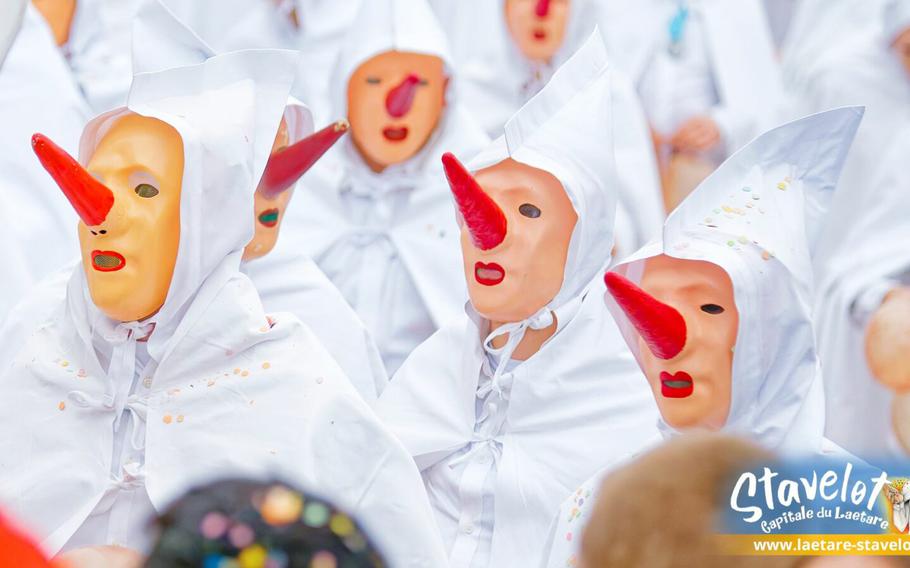
The Blancs Moussis return to Belgium this weekend as Stavelot’s three-day carnival unfolds in southern Belgium. (laetare-stavelot.be)
In the Christian tradition, the period of Lent is traditionally a time for reflection, sacrifice and spiritual renewal. On the fourth Sunday of this otherwise solemn 40-day period, the faithful are allowed a brief respite. This break comes in the form of Laetere Sunday.
Laetere, a Latin word, is the command to rejoice, and it appears in the introduction to the mass traditionally read on the day itself. Laetere Sunday is marked by carnival festivities in Wallonia, Belgium and activities marking the end of winter in and around Germany’s historical Kurpfalz region. Laetere Sunday falls on March 30 this year.
Say farewell to winter in Heidelberg: The city’s annual Sommertagszug, or Summer Day Parade, is a festive way to usher in the warmer months of the year. Starting at 3 p.m. on March 30, children will march through the Old Town, holding sticks decorated a pretzel, a hollowed-out egg and brightly colored ribbons or crepe paper. The procession departs from St. Anna Gasse and proceeds along the main street to the market square, where a symbolic battle between winter and summer unfolds, followed by dance and musical performances. Entry is free. Online: tinyurl.com/jzyun9wh
Watch the battle between summer and winter along the German Wine Road: In the small town of Forst an der Weinstrasse, located just a few miles south of Bad Dürkheim, the seasons of summer and winter take their battle to the streets in the form of a play known as the Hanselfingerhut-Spiel. From 2 p.m. March 30, two people clad as houses, one representing winter and the other summer, engage in banter and swordplay as they make their way along the street. The proceedings are at many points interrupted by a character known as the Hanselfingerhut, a prankster dressed up in a fool’s costume. Covered in blackface, he embraces the ladies present, leaving smudgy marks upon their cheeks. Festivities conclude around 3:30 p.m. with the burning of a winter effigy. Entry is free. Online: tinyurl.com/53kvkh2w
Laetere Carnivals in Wallonia, Belgium
Stavelot, a municipality in the Ardennes region of southern Belgium, keeps its carnival traditions alive from March 29-31. The stars of its festivities are the “Blancs Moussis,” playful characters dressed in white from head to toe, wearing pointy hoods and sporting long red upturned noses. These costumes, designed to resemble monks’ habits, first appeared in 1502 in response to an abbot barring the local monks from taking part in the festivities. The playful Blancs Moussis interact with the spectators by blasting them with confetti and bopping them on their heads with inflated pig bladders. The highlight of three days full of festivities is the Grand Cortège, scheduled for 1:30 p.m. March 30. Entry costs 5 euros for adults; children under the age of 12 enter free. Following the parade, the Blancs Moussis lead members of the public in a type of chain dance known as a farandole around the fountain in Saint Remacle Square. Online: tinyurl.com/mrxpmy58
The town of Andenne in Namur Province celebrates its annual Carnaval des Ours, or Carnival of the Bears, with a parade made up of some 30 floats, three giant bear puppets, and about 500 marchers clad in bear costumes. Another curiosity is a cage used to imprison local girls lining the parade’s route. The parade ends with the tossing of hundreds of teddy bears into the outstretched hands of the crowds standing beneath the Town Hall balcony. This year’s parade takes place from 2:30 p.m. March 30. Online: andenne.be/carnaval2025
The town of Fosses-la-Ville is home to Les Chinels, mysterious masked characters known for their shimmering silk and satin tunics. From 2 p.m. March 30, a couple hundred of these lavishly costumed characters will dance to their classic tunes, alongside stilt walkers, drummers and other street entertainers. Online: tinyurl.com/54cyr4fp
Volksfest in Würzburg: One of Germany’s earliest spring festivals, the Frühjahrsvolksfest, unfolds alongside the banks of the Main River. From March 29-April 13, the fest on the grounds known as Talavera attracts visitors with its foolproof mix of thrills, games and tasty treats. A giant Ferris wheel overlooks a dozen other rides geared to various levels of bravery. The striped festival tent is the place to go for traditional Bavarian bands and music spun by DJs. Running parallel to the funfair is the Häfelesmess, the sale of various household wares from booths set up in the main market square. Online: tinyurl.com/5a3dyr9k